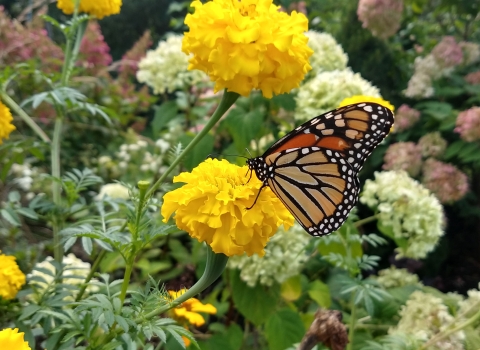Do you wistfully look back at the days of drinking from the garden hose, staying out until the streetlights came on and catching fireflies? Did you know that you can do something far cooler than dust off your Atari or crank your amp to 11? You can help make a future with more fireflies! Like music on MTV, the firefly’s environment has changed drastically since you were a kid. Now, they need your help to keep their lights on for the next generation. Myth busting is one of the many skills we have at the U.S. Fish and Wildlife Service. We’re going to let you know who the fireflies really are and what you can do to keep them from blinking out.
Attraction, deception and injection: The serious business of being a firefly
Not to ruin the childhood fun, but fireflies aren’t actually flies. Taxonomically, they are beetles, and they live all over the world. Surprisingly diverse, there are more than 140 genera with 2,400 species who all go by the name firefly. Despite the variety of names that focus on their charming glow – lightning bugs, blinkies and moon bugs – not all fireflies have bioluminescence you can see. If you grew up catching lightning bugs in a jar, you are lucky to live where their glow is strong. In the U.S., only species east of the Rocky Mountains can be seen twinkling at twilight.
The twinkle show combining the heavens with the grasses is actually key to firefly reproduction, and more serious than you imagined. The bioluminescent dance put on by males searching for their one true love may be their last act. While in the adult stage of their lifecycle, their only task is to reproduce. Some don't even eat! Their flashes, through pattern and color, signal what species and sex they are. If a female recognizes her specie’s pattern from a male, she will light up her own lantern and beckon him over.
The mating season is not all fun and games. Certain species will mimic mating flashes of another to falsely attract and kill. Injecting their prey first with paralyzing neurotoxins and then digestive enzymes, fireflies consume their liquified meals through a straw like appendage at their mouth.
If a firefly pair is successful at mating, their eggs are laid in the ground and mature into glow worms. This is the larval stage where they take shape of a worm that glows slightly – hence the name – and spend all their time eating other, tinier insects. Born and raised in the duff, they need the leaves that naturally litter the floor. That’s why it is important to leave your backyards and street sides as untouched as possible every autumn to preserve the larvae and small insects living there. This helps to ensure a healthy, new year of fireflies.
Like you and me, fireflies have needs
Love can be hard to find for even the brightest of fireflies. Even the interfering light of a full moon can outshine their visual morse code, making it impossible for males and females to recognize each other. Light pollution from towns, factories and roads have been seriously killing the buzz for these insects. And as cities grow, greenspaces shrink. Tall grass is where fireflies spend their time. When grass is cut short, or paved over completely, competition for space goes up for fireflies and successful mating goes down.
North America alone has more than 100 species of fireflies; but that may be changing. Butterflies, bees, and now fireflies, are all struggling to find places to live and reproduce. Across the country and world, people are wondering where the fireflies went. Those who remember spectacular light shows report how they have now subsided. These observations have been verified by numerous scientific studies which cite massive population declines in insects. Both the public, and scientists alike, are curious to know how our actions are affecting this major center of the food web.
As summer approaches, take a moment to decide for yourself: are fireflies and other insects as numerous as you remember when you were a kid?
Why fireflies are not as common today:
- Light pollution interferes with their mating rituals, lowering reproductive success
- Habitat loss, mainly of leaf litter and tall grasses, reduces the food and space available - halting and reversing population growth
- Pesticide exposure can disrupt their metabolism and development while in egg and larval life stages
- Climate change adds stress by exacerbating all of these threats, particularly through drought and sea level rise
Ways you can help your backyard and streetside insects:
- Turn off outdoor lights in the evening. If you have inside lights on, close the blinds
- Plant native plants
- Mow grass less frequently and raise the length of the cut to 4 inches
- When leaves drop in the fall, rake them if you want, but keep them in your yard
- Use non-pesticide solutions for insect control
- Know how much salt is necessary to de-ice sidewalks, and don’t over-do it
- Contact your city about reducing or finding alternatives to salt usage
- Watch insects closely, enjoy their presence as you learn about their bodies and behaviors
- Show others, particularly kids, how insects are interesting not intimidating
Fireflies, butterflies and bees have been in the popular club for insect conservation, but our efforts need to have a broader reach. In 2012, the National Science Foundation found the economic value of insects totaled $34 billion. Protecting our insects means protecting all animals who depend on them, including us. It’s estimated that we’ve already lost up to 10% of our insects since the industrial revolution. To reverse the decline, our love needs to be spread to more than these few flagship species.
Everyone has a role to play in conserving our fireflies. You may be okay with discarding Velveeta cheese packets and scented markers, but let’s agree that fireflies are one piece of childhood worth keeping around. Simple actions like planting native flowers, following best practices for using pesticides and supporting conservation measures to reverse the decline of insects, all have benefits. You can make a difference, and with everyone’s help, another generation can all fall asleep to ten million fireflies.
There are many ways taller grass can improve the look and function of your lawn.
How does road salt affect our environment? Find out what alternatives are available.
Learn how to make your backyard friendly for insects!
Discover an insect and pollinator lesson plan for kindergarten to second grade.







